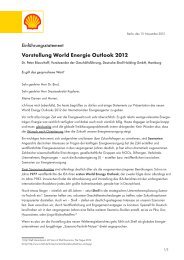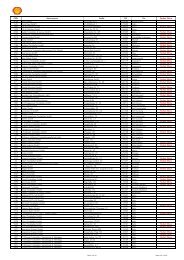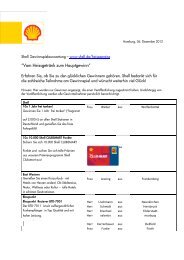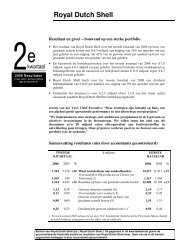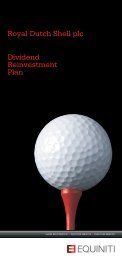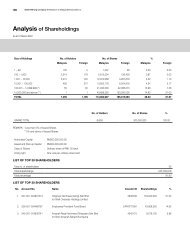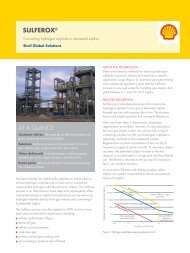ENVIRONMENTAL STATEMENT BARDOLINO DEVELOPMENT
ENVIRONMENTAL STATEMENT BARDOLINO DEVELOPMENT
ENVIRONMENTAL STATEMENT BARDOLINO DEVELOPMENT
Create successful ePaper yourself
Turn your PDF publications into a flip-book with our unique Google optimized e-Paper software.
Bardolino Development Environmental Statement<br />
source would make no significant contribution to the total source noise level at the site during<br />
the piling operations (Norton, 1989).<br />
Noise generated during pipeline installation operations<br />
The underwater noise that is produced by vessels arises from two sources – propeller<br />
cavitation and the propulsion machinery inside the vessel. Vessel noise may be considered<br />
to be a continuous, rather than transient noise source, which is a combination of broadband<br />
noise and tonal sounds at specific frequencies (Richardson et al., 1995).<br />
The noise that would be generated by the vessels would be determined by the types and<br />
numbers of vessels that are present at the site at any one time. Because the decibel scale<br />
used to measure sound is a logarithmic scale, the presence of several sources of noise at any<br />
location at any one time leads to only a small increase in the total source level of noise at the<br />
site.<br />
Published data on the sound source levels and frequencies for different types of vessels are<br />
provided in Table 6.6. Sound levels and frequency characteristics are depended on ship size<br />
and speed, with variations among vessels of similar classes (Richardson et al., 1995). Noise<br />
from shipping is roughly related to vessel size; larger ships have larger, slower rotating<br />
propellers, which produce louder, lower frequency sounds. Broadband source levels of ships<br />
between 55 and 85 m are generally around 170-180 dB re 1 µPa @ 1 m (Richardson et al.,<br />
1995), with most energy below 1 kHz. The use of bow thrusters can increase broadband<br />
sound levels by 11 dB and includes higher frequency tonal components up to 1 kHz<br />
(Richardson et al., 1995).<br />
There are currently two pipeline options which would require the operation of a number of<br />
different vessel types in the Bardolino area over a total period of 6 weeks. All would be<br />
typical of the vessels routinely used in the UK North Sea for oil and gas operations and other<br />
activities.<br />
• A dynamically positioned (DP) reel lay vessel would be used to lay the piggy-backed<br />
pipelines simultaneously onto the seabed.<br />
• Trenching would be carried out using a seabed plough towed by an anchor handling<br />
tug vessel (AHTV).<br />
• Rock dumping would be achieved by the careful placement of graded crushed rock<br />
over the pipelines, using a dedicated rock dumping vessel.<br />
• A DP dive support vessel (DSV) would be in the field for several different phases,<br />
such as tie-in spools and hydro-testing.<br />
• Guard vessels would be on site throughout the pipeline operations.<br />
• A DP survey vessel would be used to ensure that the pipes were laid in the correct<br />
location and that trenching activities were performed satisfactorily.<br />
The noise produced by subsea trenching operations depends on the equipment used and the<br />
nature of the seabed sediments. A trenching noise spectrum reported in Richardson et al.<br />
(1995) has peak levels of 178 dB re 1µPa @ 1 m at 160 Hz, with an overall source level 185<br />
dB re 1µPa @ 1 m; this is similar to the data reported by Nedwell et al. (2004). These levels<br />
are for mechanical dredging operations, and may be noisier than the proposed pipeline<br />
installation operations for the Bardolino development which would use a towed plough.<br />
During the pipeline installation operations the vessels that are likely to be present in the area<br />
include DP pipelay vessel (180 db), AHTV for trenching (170 dB), dive support vessel (180<br />
dB), guard vessel (180 dB), survey vessel (180 dB) and rock dump vessel (180 dB) (Table<br />
6.6). The estimated noise level from this combination of vessels operating simultaneously at<br />
April 2008 Page 6-21


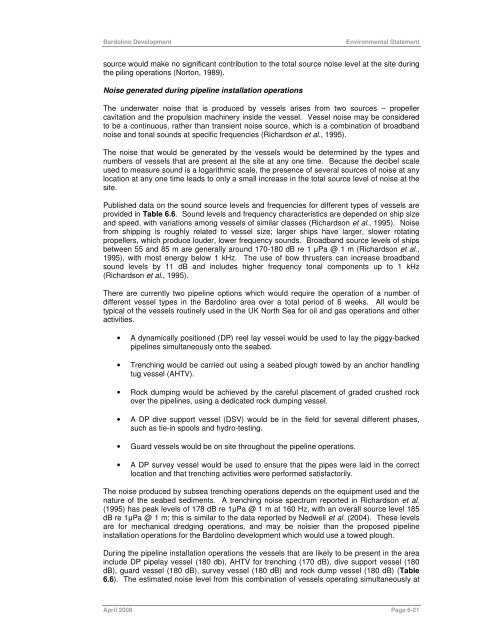
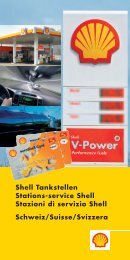
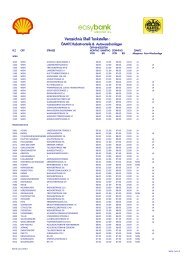
![Download Shell AutoGas Stationen [Stand: Januar 2013] (PDF](https://img.yumpu.com/9982753/1/190x245/download-shell-autogas-stationen-stand-januar-2013-pdf.jpg?quality=85)

